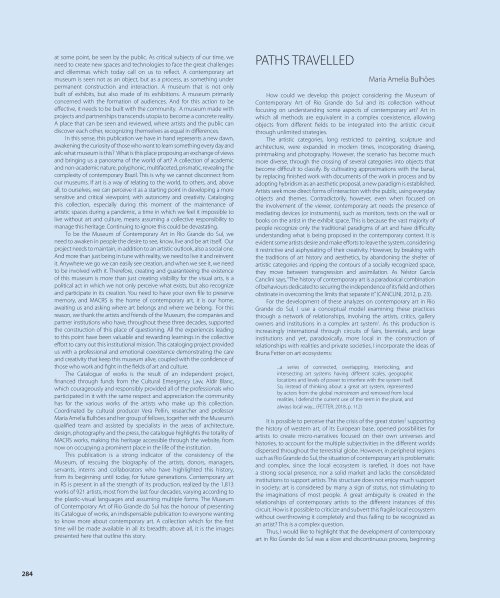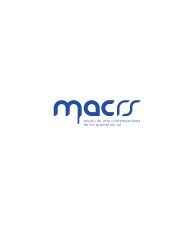Catálogo_MACRS
Create successful ePaper yourself
Turn your PDF publications into a flip-book with our unique Google optimized e-Paper software.
at some point, be seen by the public. As critical subjects of our time, we<br />
need to create new spaces and technologies to face the great challenges<br />
and dilemmas which today call on us to reflect. A contemporary art<br />
museum is seen not as an object, but as a process, as something under<br />
permanent construction and interaction. A museum that is not only<br />
built of exhibits, but also made of its exhibitions. A museum primarily<br />
concerned with the formation of audiences. And for this action to be<br />
effective, it needs to be built with the community. A museum made with<br />
projects and partnerships transcends utopia to become a concrete reality.<br />
A place that can be seen and reviewed, where artists and the public can<br />
discover each other, recognizing themselves as equal in differences.<br />
In this sense, this publication we have in hand represents a new dawn,<br />
awakening the curiosity of those who want to learn something every day and<br />
ask: what museum is this? What is this place proposing an exchange of views<br />
and bringing us a panorama of the world of art? A collection of academic<br />
and non-academic nature, polyphonic, multifaceted, prismatic, revealing the<br />
complexity of contemporary Brazil. This is why we cannot disconnect from<br />
our museums. If art is a way of relating to the world, to others, and, above<br />
all, to ourselves, we can perceive it as a starting point in developing a more<br />
sensitive and critical viewpoint, with autonomy and creativity. Cataloging<br />
this collection, especially during this moment of the maintenance of<br />
artistic spaces during a pandemic, a time in which we feel it impossible to<br />
live without art and culture, means assuming a collective responsibility to<br />
manage this heritage. Continuing to ignore this could be devastating.<br />
To be the Museum of Contemporary Art in Rio Grande do Sul, we<br />
need to awaken in people the desire to see, know, live and be art itself. Our<br />
project needs to maintain, in addition to an artistic outlook, also a social one.<br />
And more than just being in tune with reality, we need to live it and reinvent<br />
it. Anywhere we go we can easily see creation, and when we see it, we need<br />
to be involved with it. Therefore, creating and guaranteeing the existence<br />
of this museum is more than just creating visibility for the visual arts, is a<br />
political act in which we not only perceive what exists, but also recognize<br />
and participate in its creation. You need to have your own file to preserve<br />
memory, and <strong>MACRS</strong> is the home of contemporary art, it is our home,<br />
awaiting us and asking where art belongs and where we belong. For this<br />
reason, we thank the artists and friends of the Museum, the companies and<br />
partner institutions who have, throughout these three decades, supported<br />
the construction of this place of questioning. All the experiences leading<br />
to this point have been valuable and rewarding learnings in the collective<br />
effort to carry out this institutional mission. This cataloging project provided<br />
us with a professional and emotional coexistence demonstrating the care<br />
and creativity that keep this museum alive, coupled with the confidence of<br />
those who work and fight in the fields of art and culture.<br />
The Catalogue of works is the result of an independent project,<br />
financed through funds from the Cultural Emergency Law, Aldir Blanc,<br />
which courageously and responsibly provided all of the professionals who<br />
participated in it with the same respect and appreciation the community<br />
has for the various works of the artists who make up this collection.<br />
Coordinated by cultural producer Vera Pellin, researcher and professor<br />
Maria Amelia Bulhões and her group of fellows, together with the Museum’s<br />
qualified team and assisted by specialists in the areas of architecture,<br />
design, photography and the press, the catalogue highlights the totality of<br />
<strong>MACRS</strong> works, making this heritage accessible through the website, from<br />
now on occupying a prominent place in the life of the institution.<br />
This publication is a strong indicator of the consistency of the<br />
Museum, of rescuing the biography of the artists, donors, managers,<br />
servants, interns and collaborators who have highlighted this history,<br />
from its beginning until today, for future generations. Contemporary art<br />
in RS is present in all the strength of its production, realized by the 1,813<br />
works of 921 artists, most from the last four decades, varying according to<br />
the plastic-visual languages and assuming multiple forms. The Museum<br />
of Contemporary Art of Rio Grande do Sul has the honour of presenting<br />
its Catalogue of works, an indispensable publication to everyone wanting<br />
to know more about contemporary art. A collection which for the first<br />
time will be made available in all its breadth; above all, it is the images<br />
presented here that outline this story.<br />
PATHS TRAVELLED<br />
Maria Amelia Bulhões<br />
How could we develop this project considering the Museum of<br />
Contemporary Art of Rio Grande do Sul and its collection without<br />
focusing on understanding some aspects of contemporary art? Art in<br />
which all methods are equivalent in a complex coexistence, allowing<br />
objects from different fields to be integrated into the artistic circuit<br />
through unlimited strategies.<br />
The artistic categories, long restricted to painting, sculpture and<br />
architecture, were expanded in modern times, incorporating drawing,<br />
printmaking and photography. However, the scenario has become much<br />
more diverse, through the crossing of several categories into objects that<br />
become difficult to classify. By cultivating approximations with the banal,<br />
by replacing finished work with documents of the work in process and by<br />
adopting hybridism as an aesthetic proposal, a new paradigm is established.<br />
Artists seek more direct forms of interaction with the public, using everyday<br />
objects and themes. Contradictorily, however, even when focused on<br />
the involvement of the viewer, contemporary art needs the presence of<br />
mediating devices (or instruments), such as monitors, texts on the wall or<br />
books on the artist in the exhibit space. This is because the vast majority of<br />
people recognize only the traditional paradigms of art and have difficulty<br />
understanding what is being proposed in the contemporary context. It is<br />
evident some artists desire and make efforts to leave the system, considering<br />
it restrictive and asphyxiating of their creativity. However, by breaking with<br />
the traditions of art history and aesthetics, by abandoning the shelter of<br />
artistic categories and ripping the contours of a socially recognized space,<br />
they move between transgression and assimilation. As Néstor García<br />
Canclini says, “The history of contemporary art is a paradoxical combination<br />
of behaviours dedicated to securing the independence of its field and others<br />
obstinate in overcoming the limits that separate it” (CANCLINI, 2012, p. 23).<br />
For the development of these analyzes on contemporary art in Rio<br />
Grande do Sul, I use a conceptual model examining these practices<br />
through a network of relationships, involving the artists, critics, gallery<br />
owners and institutions in a complex art system 1 . As this production is<br />
increasingly international through circuits of fairs, biennials, and large<br />
institutions and yet, paradoxically, more local in the construction of<br />
relationships with realities and private societies, I incorporate the ideas of<br />
Bruna Fetter on art ecosystems:<br />
...a series of connected, overlapping, interlocking, and<br />
intersecting art systems having different scales, geographic<br />
locations and levels of power to interfere with the system itself.<br />
So, instead of thinking about a great art system, represented<br />
by actors from the global mainstream and removed from local<br />
realities, I defend the current use of the term in the plural, and<br />
always local way... (FETTER, 2018, p. 112)<br />
It is possible to perceive that the crisis of the great stories 2 supporting<br />
the history of western art, of its European base, opened possibilities for<br />
artists to create micro-narratives focused on their own universes and<br />
histories, to account for the multiple subjectivities in the different worlds<br />
dispersed throughout the terrestrial globe. However, in peripheral regions<br />
such as Rio Grande do Sul, the situation of contemporary art is problematic<br />
and complex, since the local ecosystem is rarefied, it does not have<br />
a strong social presence, nor a solid market and lacks the consolidated<br />
institutions to support artists. This structure does not enjoy much support<br />
in society; art is considered by many a sign of status, not stimulating to<br />
the imaginations of most people. A great ambiguity is created in the<br />
relationships of contemporary artists to the different instances of this<br />
circuit. How is it possible to criticize and subvert this fragile local ecosystem<br />
without overthrowing it completely and thus failing to be recognized as<br />
an artist? This is a complex question.<br />
Thus, I would like to highlight that the development of contemporary<br />
art in Rio Grande do Sul was a slow and discontinuous process, beginning<br />
284



